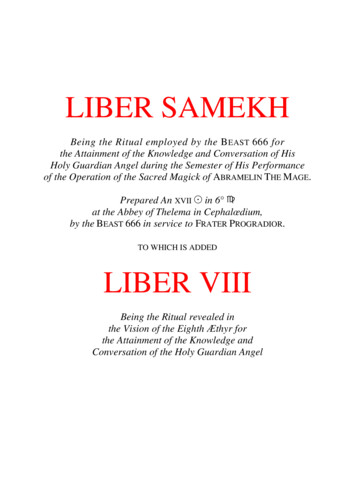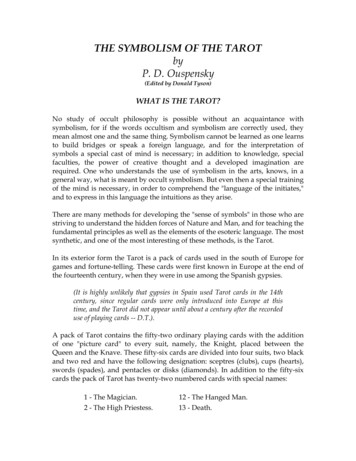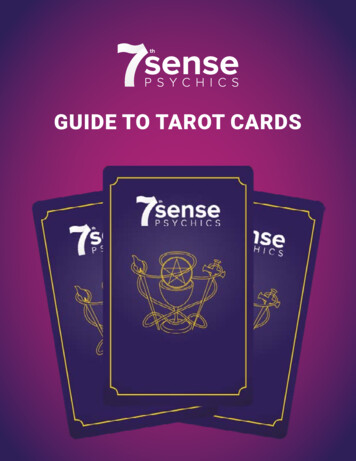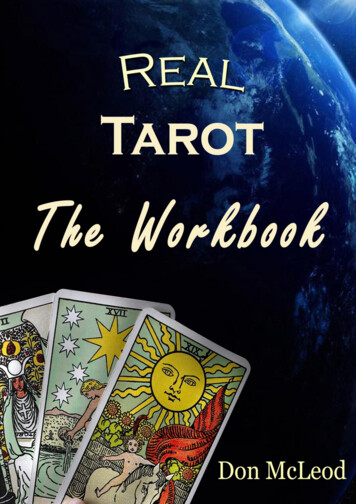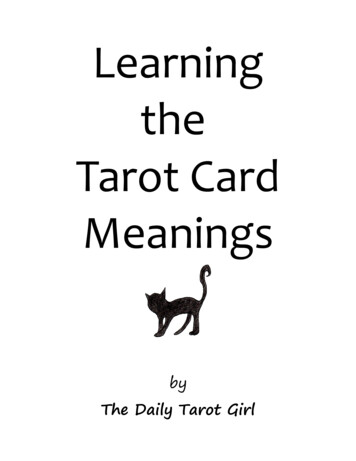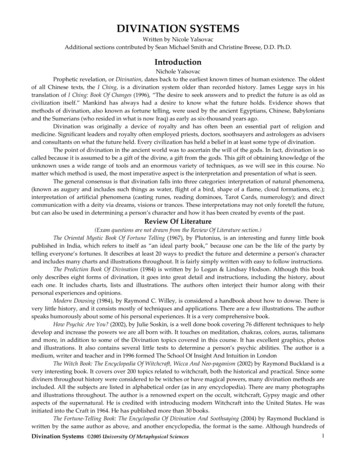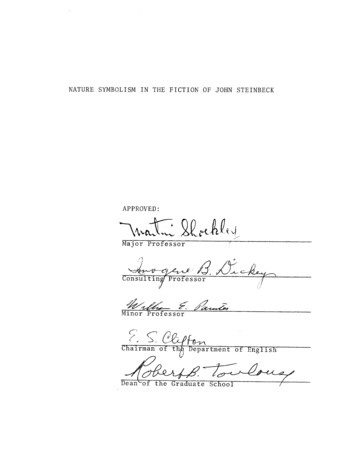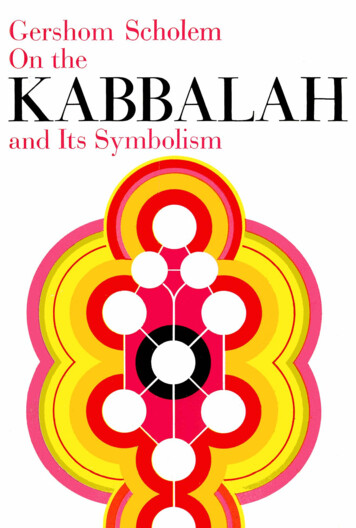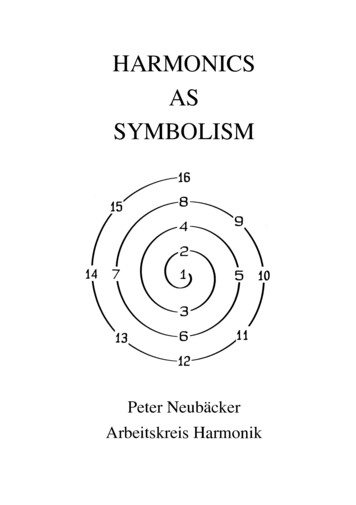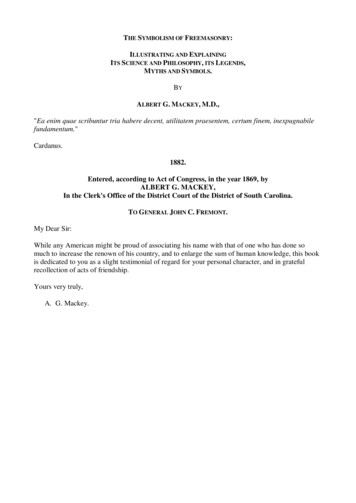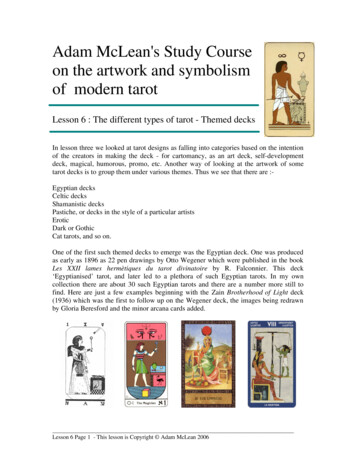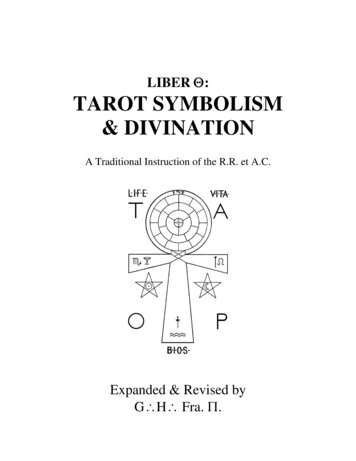
Transcription
LIBER Q:TAROT SYMBOLISM& DIVINATIONA Traditional Instruction of the R.R. et A.C.Expanded & Revised byG H Fra. P.
LIBER QTAROT SYMBOLISM& DIVINATIONA Traditional Instruction of the R.R. et A.C.Revised & Expanded byG H Fra. P.PUBLISHED BY:THE COLLEGE OF THELEMA222 North Manhattan PlaceLos Angeles, CA 90004-4018
Copyright 2012 by College of ThelemaAll rights reserved. No part of this publication may be reproduced or transmitted in anyform or by any means, electronic or mechanical, including photocopy, without permission in writing from the author. Reviewers may quote brief passages.FIRST EDITION, October, 1997SECOND EDITION, November, 1997THIRD REVISED EDITION, April 2011FOURTH REVISED EDITION, June 2012THE COVER ILLUSTRATIONconsists of a Crux Ansata, or Ankh, which is a form of the Rosy Cross. One arm isscarlet, with the symbols of and the Wand in emerald green. Another is bluewith and Cup in orange. A third is yellow, with and Dagger in violet. Thelast is in the four colors of Malkuth, with Pentacle and in black.The ring is white, having at the top the Name of the Great Angel awh. Belowthe crossbar are Pentagrams, one enclosing Sol and the other enclosing Luna.The whole space in the ring contains the Rose of 22 Petals, representing the22 Keys. In the center is a white circle and a red cross of four equal arms.About the whole symbol are the words: L.I.F.E. B.I.O.S. V.I.T.A.and the letters: T.A.R.O., Tarot.Published by: THE COLLEGE OF THELEMAA Not-for-Profit Religious CorporationPhyllis Seckler (1917-2004), FounderJames A. Eshelman, Chancellor(Donations, legacies, and bequests made to the College of Thelemaare tax deductible in the United States.)THE COLLEGE OF THELEMAFounded 1973 E.V.
With Appreciation:D.D.C.F.T.M.Q.P.F.C.
Imprimatur:Promaqeu", 8 M G H Prolocutor-General
INTRODUCTIONDo what thou wilt shall be the whole of the Law.Under the title of Book T, The Tarot, the progenitor of this present volume appeared, in themid-1890s, in the advanced curriculum of the Second Order of the Order of the Golden Dawn.That ‘Second Order’ is properly called Ordo Rosæ Rubeæ et Aureæ Crucis, “The Order of theRuby Rose and Golden Cross.” The official instruction in question, which comprised manuscripts N, O, P, Q, and R of the R.R. et A.C. curriculum for the Grade of Theoricus Adeptus Minor, was written, primarily or wholly, by S.L. MacGregor-Mathers, known within the Order asGreatly Honored Frater Deo Duce Comite Ferro (which means, “God as my guide, the sword asmy companion”).If titles and pedigree were sufficient to determine the quality of a written work, Book T surelywould deserve our attention and praise. However, the reader may rightly hope for a little substance to go with the pedigree, and possibly an original idea or two. Fortunately, it is in the matter of substance that Book T shines. Emerging at the end of the 19th Century, among a selectgroup of occult students, it is the earliest document known to give the entire, comprehensiveQabalistic key that is necessary for the full understanding of the Tarot.We shall not discuss the origins of Tarot in this short Introduction. Others have documentedits exoteric history relatively well, and there is no reason for the typical reader to accept the esoteric history, it being, by its very nature, incapable of verification. Furthermore, the history contributes little or nothing to our present subject, which is the understanding of the meanings of the78 cards of Tarot, especially as they apply to divination.Therefore, regarding origins, it should be sufficient to mention that, by the time BrotherMathers wrote his monograph, Tarot had been around for most of a thousand years, had caughtthe fancy of many generations of Europeans, and yet remained something of an enigma. Westernesoteric schools hold that Tarot was intentionally designed as a book, each card representing apage of the book; and, furthermore, that the 78 pages, being taken together, provide a perfect pictorial articulation of all of the chief elements of Qabalah.However, the key to the Qabalistic interpretation of Tarot seemed lost. It is hard to believe,however, that it was ever really lost. Once glanced upon, by anyone with even the most trivialbits of Qabalistic knowledge, it seems the most obvious thing one could imagine, at least in itsbroad points. This is part of what gives credence to the claim that there really has been an initiated oral tradition dating from Tarot’s earliest days.i
Among the principle elements of the theoretical Qabalah, we especially find: 22 letters of the Hebrew alphabet10 sephiroth, or categories of manifestation, each existing in four WorldsThe Divine Name spelled Hwhy1; its individual letters are attributed, inter alia, to ideasof Father-Mother-Son-Daughter, and to the four elementsAgainst these, we may compare the three parts of the deck of Tarot cards. Major Arcana: 22 Trumps, Atus, or Keys2Minor Arcana: 10 numbered cards, each existing in four suitsCourt Cards: 16, consisting of a Knight (or King), a Queen, a Prince (or Knight), anda Princess (or Page), in each of four suitsWith such parallels, the broad significance of these three parts of Tarot is easy to see. In aEurope where Tarot was as common as a pack of playing cards, and where the study of Qabalahwas at least as common as today, it is inconceivable that nobody would have seen, and been impressed by, the similarity of these 22, 10 4, and 4 4 structures. Even in the unlikely scenariothat Tarot somehow was not originally invented with Qabalah in mind, the two would have beeninseparably wedded in occultists’ minds long before the 16th Century ended. Yet, not a singlemention of this exists in any of the vast esoteric writings surviving from those centuries.The only sensible explanation for this seems to be that the correspondence was taken so seriously that it went underground – and that a true secret tradition has existed for centuries.In fact, this is exactly what the esoteric schools have told us, as far back as we can trace.Only with the writings of Eliphas Levi in the mid-19th Century was any popular statementmade correlating the 22 Tarot Trumps to the 22 Hebrew letters. Though Levi gave the correspondences incorrectly, it is commonly speculated that he knew the correct attributions but hadsworn not to disclose them. On this, the evidence is divided.Nonetheless, only a few decades later, something very close to the correct attribution list wasin the hands of S.L. MacGregor-Mathers and the Golden Dawn. Mathers perfectly understoodthe significance of the 40 numbered cards and the 16 Court Cards. To their basic Qabalistic correspondences is affixed, as well, a moderately complex set of astrological correspondences thatmay have been original to Mathers. If so, they are a testimony to his genius in his prime. He alsoknew the accurate correspondence of the 22 Hebrew letters to the 22 Trumps – except for twoTrumps, for which the significance of the corresponding Hebrew letters corresponding had beenobscured intentionally for over a thousand years.“Tzaddi is not the Star”Specifically, the attributions of the Hebrew letters Heh (h) and Tzaddi (x), and the corresponding Tarot Trumps called The Star and The Emperor, were erroneously reversed in theGolden Dawn scheme. The correct pattern was not known in Mathers’ lifetime. A full explanation of this discovery process is beyond the scope of this present Introduction; it was explained infair detail by Aleister Crowley in The Book of Thoth,3 with the following brief but significant123Commonly mispronounced “Jehovah” or “Yahweh”; called the Tetragrammaton, or “four-lettered name.”These three terms are interchangeable.The Book of Thoth by The Master Therion. Privately published, 1944.ii
clarification given in the Foreword to 776½: Tables of Correspondence for Practical Ceremonial:1Prior to the first decade of the 20th Century, it was wrongly thought that the Hebrew letter Heh was attributed to Tarot Trump 4, The Emperor, and to the zodiacal sign Aries; and that the letter Tzaddi was attributedto Trump 17, The Star, and to the sign Aquarius. [ ] However, in the course of Aleister Crowley’s reception of Liber Legis (The Book of the Law) in April, 1904 E.V., it was revealed that there was an error in theattribution of the Hebrew letter Tzaddi, that it was “not the Star.” When Crowley first compiled 777 in late1906, he had not yet resolved this particular puzzle; but, not many years later, he realized that the attributions of Heh and Tzaddi had been previously blinded (distorted) and should be swapped.Heh, the letter primarily associated in Qabalah with the Divine Mother, whose numerical value is 5(which most readily brings to mind the image of a pentagram), corresponds to Trump 17 called The Star, abeautiful image of the Great Mother and of maternal love, and to the constellation Aquarius which the ancient Egyptians called “the Celestial Nile” and by which they symbolized the vast body of infinite spacewhich we call the goddess Nuit.Tzaddi, a letter etymologically associated with ideas of paternity, corresponds to Trump 4, The Emperor,prime symbol of paternal will; and to the constellation Aries. Its numerical value is 90, the number of degrees in each angle of a square. Thus, the numbers 4 and 90 are inherently related.Many pages could be expended merely outlining the chief clues that these are now the correct Qabalisticattributions. Furthermore, initiates of the Thelemic Qabalistic mysteries learn far more (by both experienceand instruction) in their course of initiation than could possibly be given here. [ ]However, before leaving this subject, please note that Qabalistic teachings have stated for centuries thatthe attributions of Tzaddi have been wrongly understood. This idea did not originate in 1904 E.V. One isreminded especially of the charming allegory in the Sepher ha-Zohar, attributed to Rabbi Chananya, explaining why Aleph is the first letter of the Hebrew alphabet, yet “God” (that is, Elohim) commenced creation with the letter Beth (the first letter of Berashith, the first word of the Hebrew original of The Book ofGenesis). This story can be read in many translations and reproductions; but its gist is that each of the letters (beginning with Tav) processed by God’s throne one-by-one, each asking to be the letter wherewithCreation was commenced. Each argued its case; but God had a good reason to skip past each of them, untilBeth eventually won the honor by being the initial letter of berakha, “blessing.” Since shy little Aleph hadnot yet gotten a chance to be heard, it was awarded a special place in the scheme of things; but that woulddigress us further from the main point of the present digression, which is this: The letter Tzaddi sought tobe that force whereby the world was created because it is the initial of Tzedekim, “the righteous,” and because it is written, “The righteous Lord loveth righteousness.” In rejecting Tzaddi for this particular honor,Elohim is quoted as saying:Tzaddi, Tzaddi, thou art truly righteous, but thou must keep thyself concealed, and thy occultmeaning must not be made known or become revealed, and therefore thou must not be used in thecreation of the world.The true “occult [that is, hidden] meaning” of this letter was not then to be disclosed! Even at such anearly date, it was thus recorded in the primary foundation literature of the Qabalah that the true significanceof Tzaddi was not what it was suspected to be.Three Adepts & the 8-11 TwistThree leading personages emerging from the Golden Dawn diverged from key elements ofthe G.D. Tarot system, and made substantial contributions of their own to the 20th Century studyof Tarot. These three were Arthur Edward Waite, Paul Foster Case, and Aleister Crowley.1776½: Tables of Correspondence for Practical Ceremonial by James A. Eshelman (Los Angeles: College ofThelema, 2010).iii
Waite, Case, and Crowley all noted the same seeming inconsistency in the numeration of twoof the Tarot Trumps. Atu 8, “Justice,” is clearly and evidently related to the zodiacal sign Libra,even as Atu 11, “Strength,” is clearly and evidently associated with Leo. However, to fit the pattern that otherwise marked the G.D. Tarot model, it seemed that their numbers would need to bereversed. Waite and Case, therefore, swapped the numbers and made “Justice” Atu 11, and“Strength” Atu 8. Crowley, on the other hand, focused on the hitherto unsuspected reversal (discussed above) in the sequence of the cards attributed to Aries and Aquarius – the signs oppositeLibra and Leo. Its discovery made it unnecessary to alter the numbering of cards 8 and 11. (Reference is made, as before, to Crowley’s The Book of Thoth for a more complete explanation.)In addition to addressing this Libra-Leo issue, each of these three adepts made a distinctivecontribution: Waite (G H Frater Sacramentum Regis) was the initiated mind and motivator behindthe most widespread and successful Tarot deck of this century, if not of all time, designedby artist Pamela Coleman Smith (Soror Quod Tibbi id Aliis).Case (G H Frater Perseverantia) authored the finest and most comprehensive instruction in Tarot of all time, still available through the correspondence courses he wrote forhis organization, Builders of the Adytum. His system’s Tarot deck, drawn by JessieBurns Parke, closely resembles Waite’s in many respects but with surgical adjustments. Italso follows old Golden Dawn conventions of providing uncolored cards so that the student can paint his or her own.Crowley (G H Frater Ou# Mh, or S H Frater To Mega Qhrion) is responsible forrecognizing the need to swap the Golden Dawn attributions of the letters Heh and Tzaddi.Also, he was the inspiring spirit behind the “Thoth Tarot Deck” painted by Freda Harris,arguably one of the great artistic works of the 20th Century and certainly the most captivating Tarot rendition of all time.Liber Theta (Q) Crowley was the second to present Mathers’ Book T, and the first to publish it to a general,public audience. He included it in the September 1912 issue (No. 8) of his periodical, The Equinox, under the title “A Description of the Cards of the Tarot.” It was later given the numberLXXVIII (78) in the canon of documents for the Order A A , 78 being the number of cards inthe Tarot pack. Other than a few notes (most of which are preserved in the present edition, credited to him as “Fra. O.M.”), the usually prolific and creative Crowley added essentially nothingto the document. As published, it is substantially the Golden Dawn manuscript.That was a century ago. In the interim, continuing explorations of the Tarot have been undertaken by intervening generations of students. Better ways have been developed of presenting theunderlying instruction.The present book is an evolution of the original Book T. The initial idea was to preserve asmuch of the original as possible, because of its rich tradition and continuing value. In fact, however, much more was found needing change and expansion than was first thought. Students comparing the two documents side-by-side will easily find legacies of the original, and nothing waschanged simply for the sake of change. But much was remade.In its present form, Liber Q: Tarot Symbolism & Divination is an official instruction for asub-grade of the 5 (Adeptus) of Temple of Thelema. However, it is not a secret document.iv
Therefore, the governing authorities of Temple of Thelema have ordered this work be publishedopenly. This does not detract from the value of its study by adepts of T O T at the properpoint in their training.Those readers who simply desire a book with interpretations for each Tarot card will findwhat they seek in the present book, without need of any special prior knowledge. In fact, theycan cut straight to the summaries in Appendix A. However, they also will find that they do notunderstand 90% of the rest. In all honesty, they might be happier seeking out the popular worksof Eden Gray.Primarily, this present book teaches Tarot in terms of the philosophical model of the Qabalah. Its greatest virtue will emerge if the reader uses it, first, as a basis for intellectual study – toget a grounding – and then as a guidebook to extensive meditation on the nature of the 78 principles here expressed. Once meditation has associated the meanings of these cards to the student’sown experiences (both interior and exterior, so-called), the cards themselves will speak far morelucidly than any book could. The student then will be able to use them with actual understanding.A systematic approach is recommended. Devoting a week to each card will allow the studentto complete this cycle of meditation in about one-and-a-half years – some of the most amazingyears of one’s life, we are certain. (We shall say more below about the recommended course ofmeditation.)The 22 Major ArcanaSimplest – in theory – of the three parts of Tarot are the 22 Trumps, called the Major Arcana,or “Greater Mysteries.” In the Third Edition of this book, these have been moved to Chapter 1,where they rightly belong as the foundation for all of one’s Tarot studies.The 22 Trumps correspond to the 22 letters of the Hebrew alphabet. A complete, accuratetabulation of these correspondences is given on page 7. To each are also attributed other symbols, astrological and philosophical. The provided divinatory meanings are based on those ofG H Fra. D.D.C.F. (Mathers), expanded somewhat by notes of G H Fra. O.M. (Crowley)and by G H Fra. P. (Case). They are almost entirely based on the simple astrological correspondences of the Hebrew letters. Those given for Aleph (a), Mem (m), and Shin (?) correspondclosely to the astrological significance of Uranus, Neptune, and Pluto, respectively.In addition to the traditional divinatory paragraph for each card, an “Esoteric Meaning” hasbeen added. This summarizes some of the more important Qabalistic cues to the meaning of eachcard, for those who wish to penetrate more deeply. These “Esoteric Meanings” consist primarilyof the text of a medieval document called The 32 Paths of Wisdom. The translations used areoriginal to College of Thelema and Temple of Thelema. In addition to this text, the “EsotericMeaning” contains a concise statement of the nature of each letter based on its position on theTree of Life. Those who are familiar with this Qabalistic diagram, and the placement on it of the22 Hebrew letters, will have no difficulty drawing abundant meaning from these few words.In this Fourth Edition, I have added a versicle near the top of each Trump page. These poeticpassages, rich in visual and emotional imagery, are from a devotional work titled Liber Amorisvel Calicis that was a fruit of parabhakti practices in 1997. These verses express the intimacybetween the adept and the Holy Guardian Angel in terms of each letter of the Hebrew alphabet.They may be of assistance in understanding the deeper implications of each card in terms of itsletter symbolism and placement on the Tree of Life.v
The 40 Minor ArcanaTwo types of symbols are joined in the formulation of the 40 small cards, called the MinorArcana, or “Lesser Mysteries.” These cards are arranged in four suits, to each of which are givencards numbered from 1 through 10.These 10 numbers are the 10 sephiroth of the Tree of Life, mentioned previously. They maybe studied in standard references, such as The Mystical Qabalah by Dion Fortune. The four suitscorrespond to the four letters of the Divine Name Hwhy, Yod Heh Vav Heh, to the four elementsof the alchemist, and to the four Qabalistic Worlds. The table below summarizes these MotherSonDaughterFireWaterAirEarthAtziluth, the Archetypal World (Godhead)Briah, the Creative World (Spiritual)Yetzirah, the Formative World (Astral‐Psychological)Assiah, the World of Action (Physical‐Material)Thus, the 5 of Cups, for example, corresponds to sephirah 5 (called Geburah, “strength” or“severity”) in relationship to the letter h. It therefore means “emotional severity” which requires“emotional strength” to endure. Similarly, the 6 of Swords corresponds to sephirah 6 (calledTiphereth, “Beauty”) in the realm of the letter w, which is especially the mental world. It therefore represents balance, proportion, and “beauty” of the intellect.Additionally, there is an astrological correspondence to each Minor Arcanum, except for theAces. (The Aces are the “root” principles of each element.) For symbolic convenience, each ofthe 12 signs of the zodiac is divided into thirds, of 10 each. These are called decanates. To eachof the decanates is assigned a supplemental planetary rulership. These, and their correspondenceto the small cards, are given on page 6. The key to the arrangement can be decoded with just alittle bit of attention, so it seems more valuable to leave it as an exercise than to explain it here.Thus, two pairs of ideas relate to each Minor Arcanum. To the 6 of Swords mentioned previously is attributed not only the idea of sephirah 6 (Tiphereth, “beauty,” the Sun) in the element ofAir; there is also the 10 segment of Aquarius attributed to Mercury. Air and Sun/Tiphereth, plusAquarius and Mercury, gives a complete picture of the card. The two planetary ideas – in thiscase, the Sun and Mercury – can be combined further with the knowledge of the astrologer, togive a synthesis of the most important ideas. The test of our understanding may be to compareour conclusions thus far to the symbolic title of the card, “Science.”Technical details of the Minor Arcana are given in Chapter 2, including detailed interpretations of each card. (Each card is individually listed in the Table of Contents as well.)Each description begins with a physical description of the small card. These are based closelyon the Golden Dawn designs. The Thoth deck also follows them closely, though not invariably.Separate interpretive paragraphs are given for the combination of sephirah and element; theplanet and sign ruling the corresponding decanate of the card; and the blending of the two planetary principles thus derived. (This last paragraph, which often will contain the ideas that mostquickly summarize the nature of the card, is an innovation in this book.) The interpretations arefounded on traditional Golden Dawn interpretations, but better organized according to the symbols so that the student can derive understanding rather than just information. Furthermore, wehave enriched the traditional meanings with embellishments, based especially on astrologicalsymbolism and Qabalistic psychological states of the principles natural to each card.vi
The 16 Court CardsSixteen cards remain to be discussed. They are the four Court Cards in each of the four suits.Their symbolism is far more complex than that of either of the other two parts already discussed.Ironically, they always have been discussed first in all prior incarnations of Book T.In the present book, these Court Cards receive a deeper and more comprehensive discussionthan they ever have before.Two separate ideas enter into the symbolism of each of these Court Cards. The first is thatthey represent 16 sub-elements – that is, the expression of each of the four letters of the Tetragrammaton (Hwhy) in each of the four elements or four Worlds.The second symbol-set for these cards is zodiacal. Its basis, to our knowledge, never has beenadequately (or even minimally) explained before, but is explained in the present book. EachKnight, Queen, and Prince corresponds to a 30 part of the Zodiac that does not stay withinbounds of a zodiacal sign. Instead, each is attributed to the last 10 of one sign, and the first 20 of the next. The reason for this strange system is carefully explained in Chapter 3. The symbolism of the three decanates (which, you will recall, each correspond to one of the Minor Arcana)plays heavily into the meaning of the card.The fourth card in each suit, the Princess,1 is attributed to an entire quadrant of the heavens, a90 segment overlapping those three zodiacal signs that are centered on the Fixed, or Kerubic,sign of the element to which the Princess corresponds.The discussions following explain how these principles combine and interweave, and howcomplex human character patterns burst forth from these symbols.Tarot’s Hidden LanguageOne of the greatest contributions of this present book is that it provides a paced program forbuilding each of these 78 symbol sets into the patterns of your subconscious mind. This is accomplished in layers, beginning with the Trumps or Greater Arcana; then moving to the LesserArcana, the meaning of which is founded on the Trumps; and concluding with the Court Cards,knowledge of which is built atop one’s understanding of the Majors and Minors.Learning to truly read the Tarot (rather than simply regurgitate learned meanings) rests onthorough, systematic meditation on the cards. Books do not have most of what you need forthis because you have to get it from within yourself. You need to learn certain core definitions,and need to establish them in right relationship to each other in your subconscious mind. Thenthe real instruction begins! We state as plainly as possible this key to the esoteric language ofTarot: The traditional divinatory meanings actually written in this book are a veil. The deeperlanguage is learned by applying the methods prescribed in each chapter.Figuratively speaking, each Trump is a word; each Minor is a sentence composed of severalwords; and each Court Card is a paragraph composed of several sentences.As with native language skills, this assimilation has its own pace. The best, longest-lastingresults have been produced when students spend no less than three days incorporating each card– each meme, or transmissible unit of consciousness – into their brains. At this pace, the basics of1Sometimes called the Page; but this loses her most important symbolism, i.e., that she is the Daughter, Bride,and Queen of the Kingdom.vii
the entire Tarot will be assimilated in 39 weeks, roughly the time it takes a woman to make a baby. And, as when gestating a baby, it does not help to rush things!After this initial nine months, a further 78-week pass through the cards is advised (one weekfor each card). These primary and secondary passes, thus, take about 27 months, at the end ofwhich your mind will be perceiving, thinking, and speaking in the hidden language of Tarotwhich has never been written because it does not exist in the words of any spoken language.Dialogue With the DivineThe final chapter of the book deals with the art of divination – of drawing insight on the past,the present, and the future from correct use of Tarot cards.“Divination,” of course, is derived from the word “divine.” It differs from simple “fortunetelling” because it is foremost an entering into relationship with the Divine. Once the language ofTarot is incorporated into your cells, the cards become primarily a focus of intuition. Properlyunderstood, they present a series of symbols that lead the mind into a deeper relationship withthe principles pertaining to the problem under consideration. This focus on principles providesthe querent – yourself or another – a basis for choice, rather than a dogmatic pronouncementabout the future.The first method of divination given in Chapter 4 is believed to have originated with theGolden Dawn. It has been rewritten, based on feedback from students, in an effort to make itmore comprehensible and usable. A second, much simpler, yet relatively unknown nine-cardmethod is given, which many students have found valuable is assessing the psychological andspiritual conditions within which they are living.Love is the law, love under will.James A. EshelmanFRA. Promaqeu"Prolocutor-GeneralTemple of Thelemaviii
CONTENTSIntroduction . iA Description of the Cards of the Tarot.3Titles of the Symbols .5The Descriptions ofThe Seventy-Eight Symbols ofTHE BOOK OF THOTHTogether With Their MeaningsChapter 1: THE MAJOR ARCANA .11Meditation on the Major Arcana .120. The Fool .13I. The Magus .14II. The Priestess .15III. The Empress .16IV. The Emperor .17V. The Hierophant .18VI. The Lovers .19VII. The Chariot .20VIII. Adjustment .21IX. The Hermit .22X. (The Wheel of) Fortune .23XI. Lust .24XII. The Hanged Man .25XIII. Death .26XIV. Art .
3 The Book of Thoth by The Master Therion. Privately published, 1944. iii clarification given in the Foreword to 776½: Tables of Correspondence for Practical Ceremoni-al:1 Prior to the first decade of the 20th Century, it was
